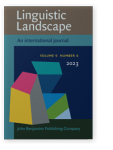Vol. 9:4 (2023) ► pp.387–412
Contextual graffiti and collective action frames at the Chilean social outbreak in 2019
Protest graffiti as visual activism provides a democratic space for demonstrators to articulate their narratives. Nevertheless, the lack of leadership in the Chilean social outburst in 2019 becomes a challenge in outlining its impact. Thus, this article provides an empirical case of political graffiti and explains how graffiti had a constitutive role in the social movement and the immediate country’s political course after that. This paper proposes a transdisciplinary approach by combining the analysis of graffiti as contextual texts (Pennycook, 2007) with ‘collective action frames’ in studying political graffiti collected in a six-kilometre walk in Santiago, Chile. As a result, graffiti frameworks of injustice denounce the state and police violence; frameworks of agency tend to organise protesters’ ideas for change, such as a new constitution and the end of the current pension systems; and a strong sense of feminism conforms part of identity frames.
Article outline
- 1.Introduction
- 1.1Literature review
- 1.2A short history of the social movement in 2019
- 1.3Positionality as a Chilean researcher
- 2.Social movement studies into the Linguistic Landscape research
- 2.1Transmodal graffiti in arenas of conflict
- 2.2Methodology and outcomes
- 3.Analysis
- 3.1Diagnosing the injustice of the model
- 3.1Feminism in the movement’s identity
- 3.3Movement’s agency through a new constitution
- 3.4Intertextual relationships between CAF components and the new constitution
- 4.Conclusions
- Notes
-
References
